Fruitful fruit growing
Some fruit trees are hard work: grubs, bugs, fungal disease, sunburn in summer, frost damage in
winter - the whole calamity.
Others, however, produce wonderful fruit for minimal effort. The following varieties have done well over
the years in our Melbourne garden: persimmons, blueberries, cherry (strawberry) guavas,
raspberries and brambleberries, tamarillos and of course citrus.
Persimmons
Glossy, dark green leaves turn brilliant shades of orange
in autumn, and in winter beautiful orange-red globes hang
from bare branches and provide a winter feast.
Non-astringent varieties like Fuyu can be eaten when firm,
but their taste is richest when fully ripe and soft.
Persimmons are mostly disease free but expect to net
your tree or blackbirds, Indian mynahs, currawongs,
lorikeets and ravens will beat you to the fruit.
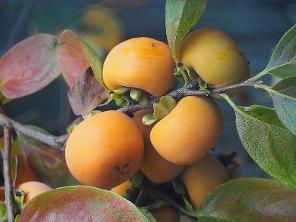
Persimmons ripen as the leaves begin to take on their autumn tones.
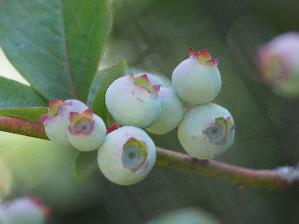
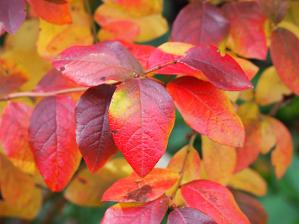
Blueberries
Blueberries need an acid soil with plenty of organic
matter in it. They also need need water, and plenty of it.
They would probably do well in a wicking bed.
However, if you can provide these, an established bush
will give you many, many delicious berries over quite a
few weeks. Planting a few different varieties will give you
an extended harvest.
These are lovely bushes: as well as their berries, they
produce pretty white flowers and vividly coloured autumn
leaves.
They are remarkably disease and pest free... except for
birds. You will need to net your bushes.
In extreme heat it is advisable to give blueberries a
protective shade cloth cover. The framework you use for
bird netting will be useful for this.
Cherry Guava
(Psidium littorale)
Also known as Strawberry Guava, or Lemon
Guava in the case of the yellow variety.
Pretty, fluffy, white flowers precede delicious
fruit on a small ever-green tree that is pretty
much disease-free and drought tolerant.
The fruit are small (2-2.5cm diameter) but
when fully ripe they pack a punch: sweet, juicy
and tangy, as well as high in Vitamin C.
They ripen over a number of weeks, and are
wonderful to snack on while working in the
garden.
In warmer climates these plants can self-sow
and become an environmental weed, but in
Melbourne this doesn't seem to be a problem.
Plant in a warm spot.
The birds may steal the fruit but otherwise
these are very trouble free plants.
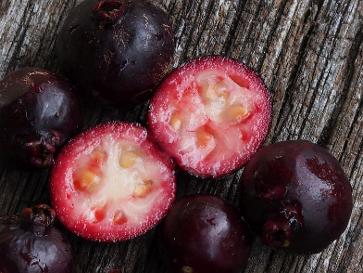
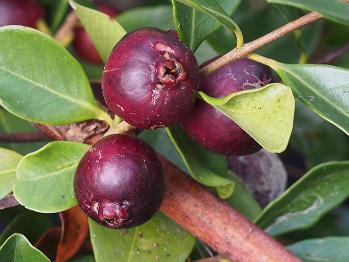
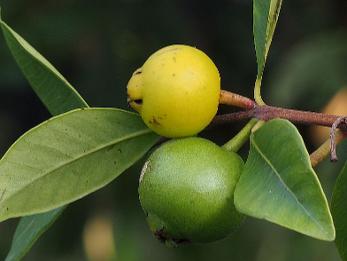
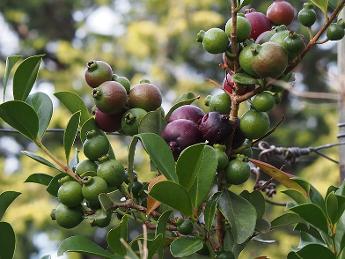
Tamarillos
These elegant small trees don't have a long life but they will self
seed so you can keep propagating new ones. They are
understorey plants in their natural habitat, so plant in a protected
spot out of the worst of the summer heat. Keep them well
watered.
The shiny red fruit hang like decorations on a Christmas tree.
Eat them 'au naturel', scooping the flesh out with a spoon, drop
them into boiling water to remove the skins then slice and
sprinkle with sugar, or chop and use to top a pavlova (yum!), or
mull them in red wine with sugar, spices and lime peel.
Birds and possums don't go much for tamarillos - their skins
taste nasty. They are, however, prone to attacks of aphids and
white fly. Pyrethrum sprays will help control these.
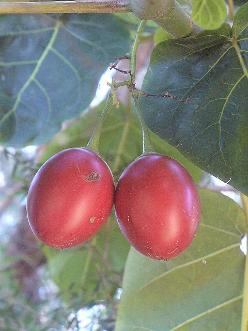
Citrus
Everyone knows how useful a backyard lemon
tree is, but don't stop there! Mandarins, tangelos,
oranges, grapefruit, limes and cumquats all grow
well in Melbourne and there are enough varieties
available to give you fruit throughout the year.
Given a bit of basic care, citrus will fruit prolifically
and reliably.
They need an acid soil, well drained rather than
boggy, a regular scatter of good citrus food (try
Dynamic Lifter for Citrus), and a decent water
supply in hot dry periods.
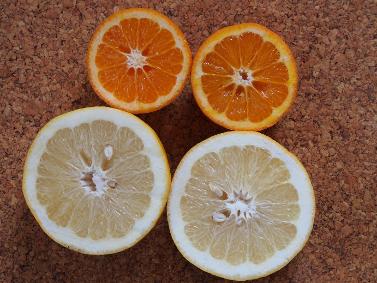
A well cared for tree will be less troubled by pests and diseases.
Probably the most trying problem is gall wasp. Tiny wasps lay eggs under the bark of young citrus
stems causing swollen lumps to form. These must be removed and destroyed before September or a
new generation of wasps will hatch out and re-infect your tree(s), and your neighbours' as well.
Use the microwave, the oven or the fireplace to destroy the developing wasps in the galls.
Tangelos
These are beautiful rounded trees, and on those cold, grey
winter days their bunches of deep orange fruit make a
bright splash of colour, cheering you instantly.
Tangelos can be tricky to peel but they are easy to juice.
The fruit can be picked from around July, and although
initially quite tart, it hangs well on the tree for some
months, becoming sweeter and sweeter.
Tangelo trees can be troubled by gall wasp, but
infestations don't seem to be as heavy as on lemons and
oranges.
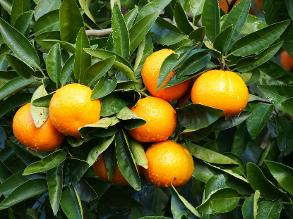
Mandarins
One taste of your sweet, tangy, juicy home grown mandarins and you won't want shop-bought ones
again!
Plant a variety of these small trees and you will have fresh mandarins for most of the year:
Japanese Seedless ripens early, around April; pick Emperor mandarins from about May; Honey
Murcott is the latest and can keep you fed until well into summer.
In our garden Emperor and Honey Murcott seem resistant to gall wasp, but do keep a watchful eye
on them just in case.
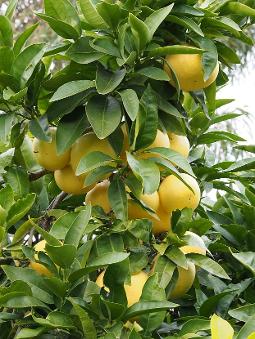
Grapefruit
Grapefruit can be a little tart in cooler climates, but they still
make excellent marmalade and their juice can be mixed
with orange juice for a delicious fruit drink.
Grapefruit and lemon cordial is very refreshing in summer.
Be aware that the red grapefruit (eg.Ruby) will not develop
the full red colouring in cooler areas including Melbourne.
Watch out for gall wasp infections on grapefruit trees.
Cumquats
These small trees are very trouble-free. The perfume of their blossom will entice you into the garden
regardless of the weather, and the beauty of the fruit alone makes these trees worthy of a spot in the
garden.
Cumquats make the best marmalade. They can also be used for cumquat brandy, or chopped and
added to muffins and cakes for a tangy burst of flavour. Cumquat juice added to iced water with a
spoonful of sugar makes a refreshing summer drink. In warmer countries, like the Philippines, cumquat
juice is used in place of lemon juice in salads, curries etc.
Gall wasps don't attack cumquat trees.
Limes
Pick a warm spot for your Tahitian Lime tree.
Limes are deliciously spicy and aromatic.
Kaffir (Makrut) Limes like a warm spot too. Use their leaves
or the grated rind of their knobbly fruit in Thai-style curries.
Other than gall wasps these limes are fairly trouble free.
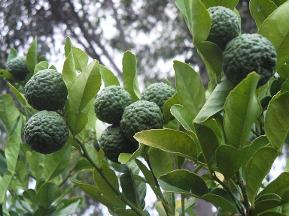
Kaffir, or Makrut Limes
Oranges
Homegrown oranges have a wonderfully rich flavour that beats commercially grown fruit hands down.
Choosing a variety of types will give your oranges over a long period. Be aware that Blood Oranges
may not colour up in Melbourne's climate.
Keep a watchful eye out for galls.
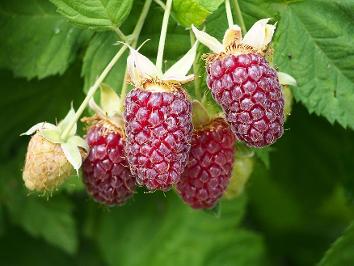
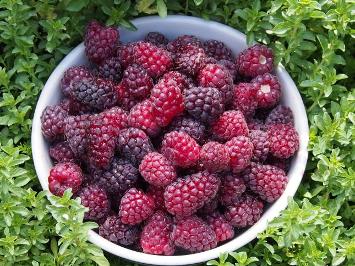
Raspberries and Brambleberries
Easy to grow, not quite so easy to train, but
with a bit of trial and error you will work out a
system.
Berries are expensive to buy, so having a
mixed berry patch at home is a good thing.
Freeze surplus fruit and have berries all year
round.
Choose a spot away from the hottest summer
sun and keep these bushes well watered and
fed (try Sudden Impact Rose Food) for
bumper crops.
Build a walk-in berry cage to keep the birds at
bay. Other than dealing with these thieves
you may need to spray occasionally with a
copper spray to prevent fungal diseases, and
with PestOil or similar if the plants develop
scale. It's worth the trouble though for the
fresh berries.